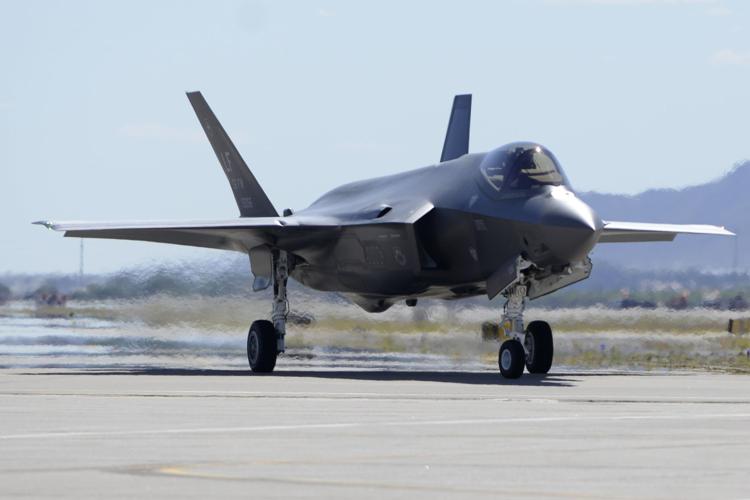The F-35 Joint Strike Fighter is to replace most of the nation’s front-line fighter jets over the next decade.
The Air Force plans to buy nearly 1,800, but it’s uncertain whether any will regularly fly in and out of Davis-Monthan Air Force Base.
“I don’t see the F-35 being based here, at least anytime soon,” Arizona Sen. John McCain said during a meeting with the Star editorial board last August.
D-M was passed over when initial F-35 basing decisions were made in 2011. Luke Air Force Base in Glendale was selected as a training base and Marine Air Station Yuma was chosen as a base for the vertical-takeoff version, the F-35B.
If D-M is considered in the future, the Air Force would take into account its long runway, good flying weather and easy access to the nearby Barry M. Goldwater Air Force Range, a vast training area.
The Air Force would also assess noise and other effects of the jet, as required under the National Environmental Policy Act.
That process would likely generate vehement opposition from some residents in the flight path who contend the F-35 is too loud and unproven for an urban air base.
Tucson Forward, a group formed to stop the F-35 from coming here, says the jets would make a swath of midtown unlivable because of noise and emissions.
The group says single-engine jets like the F-35 and the F-16 pose higher crash risks because they lack backup engines.
In 1978, a single-engine A-7D Corsair fighter from D-M crashed near the University of Arizona campus, killing two UA students.
“Tremendously loud”
Tucson Forward’s objections to the F-16 go beyond its engine. F-16s from the Air National Guard 162nd Fighter Wing at Tucson International Airport visit D-M frequently for training, and a small squadron of Air Guard jets has been based at D-M since September 2001.
“It is extremely loud, and the ones here now are in violation of the law,” says Tucson Forward President Mary Terry Schiltz. She contends the Air Force never conducted the required environmental assessment of the fighter jet.
Tucson Forward objected when the Air National Guard’s 162nd Fighter Wing at Tucson International Airport was identified as a candidate for the F-35 in 2009. The 162nd, which is a major training site for foreign F-16 pilots, also was passed over as an initial F-35 base.
Most recently, the group filed comments objecting to a planned expansion of visiting-plane training, including Operation Snowbird, which often brings louder jets. But on May 15, the Air Force issued a final decision to expand the operation at D-M after issuing a “finding of no significant impact” on the local environment.
Schiltz says her group is weighing its options, including a legal challenge.
She says D-M supporters should work to persuade the Air Force to find other uses for the base.
“We’re looking at alternative solutions to keep the base open,” she says. “It’s not our mission to try and get the base shut down.”
Dr. Jean-Paul Bierny, a retired radiologist and Tucson Forward supporter, says jet noise has gotten worse since he moved into the El Encanto neighborhood near Reid Park in 1971.
“It’s a matter of when aircraft noise gets so loud it affects long-established neighborhoods,” he said. “Who would want to retire here if you have these overflights of tremendously loud airplanes?”
Air Force ready to move forward
Experience elsewhere shows that the Air Force is sensitive to community concerns, but it is prepared to press ahead with its plans.
It settled a lawsuit filed in 2009 by Valparaiso, Florida — home to Eglin Air Force Base, where F-35 pilots train — that said noise would devastate the small city. The settlement calls for mitigation to minimize flyovers and sound from the F-35s.
A group of homeowners in Burlington, Vermont, has sued to prevent F-35s from being housed at the Air Guard base there, also because of noise.
Schiltz stopped short of saying Tucson Forward would sue to keep the F-35 from coming here but added, “We would seriously consider any options we have.”
D-M would likely get — at most — one F-35 squadron of 18 to 24 jets. But as the Air Force replaces most of the nation’s fighter jets, some may pass through D-M for training. Any shift to F-35s would require an environmental analysis under federal law.
Air Force spokeswoman Ann Stefanek says that while urban bases may have more community sensitivity to aircraft noise, each base and proposed mission are considered individually.
“I would not say there is any kind of preconceived decision,” she says. “You’ll look at all of the factors in the basing process: what criteria the major commands feel are important for that installation to have, and what attributes make it particularly suited from a mission standpoint.”





